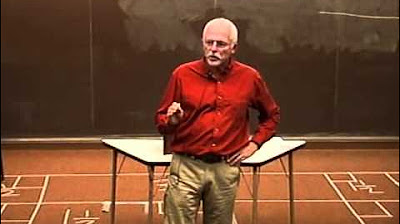How to Get Students to LOVE Learning: The Voluntary Classroom
TLDRThe video script addresses the issue of student lethargy in classrooms and proposes a solution where teachers reframe their perspective, viewing their classrooms as voluntary organizations. By doing so, teachers should create a compelling vision for learning and use storytelling to inspire students, emphasizing the importance of understanding why they study and how their education connects to real-world problems. The speaker shares personal anecdotes to illustrate the balance between academic responsibilities and life choices, ultimately aiming to motivate students to engage more actively in their own learning process.
Takeaways
- 📚 Teachers face increasing student lethargy, with students expecting high grades but being unwilling to put in the necessary work.
- 🌟 A solution is to view classrooms as voluntary organizations, where students feel they have a choice to be there and are more likely to be engaged.
- 🤔 The third cause of student lethargy is the compulsory nature of education, which does not inherently inspire hard work or motivation.
- 🎯 To combat this, teachers should strive to make their classrooms materially different and more engaging for students.
- 💡 A key aspect of motivating students is articulating a clear and compelling vision for the purpose and value of education.
- 📈 Teachers should connect the relevance of their subject matter to real-world problems and students' lives to create a meaningful learning experience.
- 📖 Storytelling is a powerful tool for teachers to shape students' understanding and expectations regarding effort and outcomes.
- 🏆 Students need to understand that good grades come from consistent effort and following through on class requirements.
- 🥇 Teachers should share personal stories that illustrate the balance between academic responsibilities and other life commitments.
- 🌈 It's important to create a classroom environment where students feel their efforts are valued and where they can succeed without feeling overwhelmed.
- 💌 The ultimate goal is to reduce student lethargy and increase their motivation and engagement in learning, which can lead to a more fulfilling teaching and learning experience.
Q & A
What is the main issue addressed in the video?
-The main issue addressed in the video is the increasing student lethargy and the expectation of high grades without putting in the necessary work.
What are the three causes of student lethargy mentioned in the video?
-The three causes of student lethargy mentioned are COVID, phones, and the fact that students are compelled by law to attend school, which does not inspire hard work.
How does the speaker propose to change the classroom environment?
-The speaker proposes to change the classroom environment by viewing it as a voluntary organization, where teachers act not only as instructors but also as leaders.
What is the significance of having a compelling vision for education in the classroom?
-A compelling vision for education helps students understand the purpose and importance of their learning, which can inspire and motivate them to engage more actively in their studies.
How does the speaker use quotes and personal stories to connect with students?
-The speaker uses quotes from William Faulkner and Alistair Gerard, as well as personal stories about his own experiences, to illustrate the relevance of history and the importance of critical thinking in students' lives.
What is the advice given by the speaker's father-in-law about achieving good grades?
-The advice given by the speaker's father-in-law is to show up to class and do what the professors tell you to do, as this will lead to good grades.
What is the lesson from the speaker's story about the term paper written during a weekend trip?
-The lesson from the story is that choices have consequences, and while the speaker did not regret the experience with his wife, he received a grade that reflected the effort he put into the paper.
How does the speaker use storytelling to shape students' expectations and understanding?
-The speaker uses storytelling to create a shared language and understanding of the relationship between effort and grades, helping students to see the value in putting in the work required for academic success.
What is the speaker's stance on teachers taking on more work to solve student lethargy?
-The speaker is not advocating for more work for teachers but rather for a mindset shift where teachers view their classrooms as voluntary organizations and focus on inspiring students through vision and storytelling.
How does the speaker address the issue of students having many extracurricular activities and responsibilities?
-The speaker acknowledges that students may have many responsibilities but emphasizes that choices have consequences, and it's up to the students to decide if they are willing to accept the potential impact on their grades.
What is the ultimate goal of the speaker's approach to teaching?
-The ultimate goal of the speaker's approach is to combat student lethargy by inspiring and motivating students through a clear vision of the purpose of education and by using storytelling to create a shared understanding and engagement with the material.
Outlines
📚 Addressing Student Lethargy and Classroom Mindset
The speaker discusses the increasing issue of student lethargy and the expectation of high grades without the corresponding effort. They propose a shift in the teacher's perspective, viewing the classroom as a voluntary organization. The speaker emphasizes the importance of a compelling vision for education and the need for teachers to become leaders. They argue that this mindset change can enhance both teaching and learning experiences.
🌟 Inspiring Students through Vision and Storytelling
The speaker shares strategies to motivate students by constantly reminding them of the 'why' behind their education. They highlight the significance of writing and critical thinking in addressing societal issues and achieving personal goals. The speaker uses personal anecdotes to illustrate the relationship between effort and academic outcomes, emphasizing that choices have consequences in the form of grades. They advocate for storytelling as a means to create a shared language and understanding within the classroom.
Mindmap
Keywords
💡student lethargy
💡voluntary organizations
💡leadership
💡vision
💡storytelling
💡educational standards
💡engagement
💡workload
💡personal responsibility
💡expectations
Highlights
The increasing issue of student lethargy and the expectation of high grades without the corresponding effort.
A proposed solution to change the view of classrooms, treating them as voluntary organizations to foster a sense of choice and motivation in students.
The importance of understanding the causes behind student lethargy, including the impact of COVID and the use of phones.
The compulsory nature of education and how it may not inherently inspire hard work and dedication in students.
The necessity for teachers to become leaders in their classrooms, going beyond instructing to effectively guide and motivate students.
Creating a well-articulated vision for the classroom to provide students with a clear understanding of the purpose and value of their education.
The use of storytelling as a powerful tool to connect with students, shape their expectations, and establish a shared language within the classroom.
The personal story of the teacher being the first in their family to go to college and the simple yet effective advice given by their father-in-law on succeeding academically.
The anecdote of choosing between working on a term paper and spending a weekend in the mountains, highlighting the importance of balancing work and personal life.
The outcome of receiving a C for a subpar term paper, emphasizing that grades reflect the effort put in and that sometimes other experiences are worth it.
The concept of 'showing up and doing what you're told' as a straightforward approach to achieving good grades in school.
Addressing the common student objection of having too many commitments and the trade-offs between various activities and academic performance.
The role of the teacher in supporting students' choices, even if it means accepting lower grades, and encouraging them to live a full life.
The effectiveness of using relatable stories to remind students of the importance of putting in the necessary work to achieve their goals.
The impact of a teacher's mindset change on their teaching style and the potential to increase both their and their students' pleasure in teaching and learning.
The importance of aligning the tasks given to students with a broader vision and the relevance of their education to real-world problems.
The role of voluntary organizations in motivating members and the application of similar strategies in the classroom to combat student lethargy.
Transcripts
Browse More Related Video

Let's use video to reinvent education | Salman Khan

Stopping the crisis: Oregon teachers, parents consider solutions to stop classroom outbursts

School Memes Teachers Won't Show You

Stop Teaching, Start Learning | Mariappan Jawaharial | TEDxEchoPark

Marty Lobdell - Study Less Study Smart

Should we let students use ChatGPT? | Natasha Berg | TEDxSioux Falls
5.0 / 5 (0 votes)
Thanks for rating: